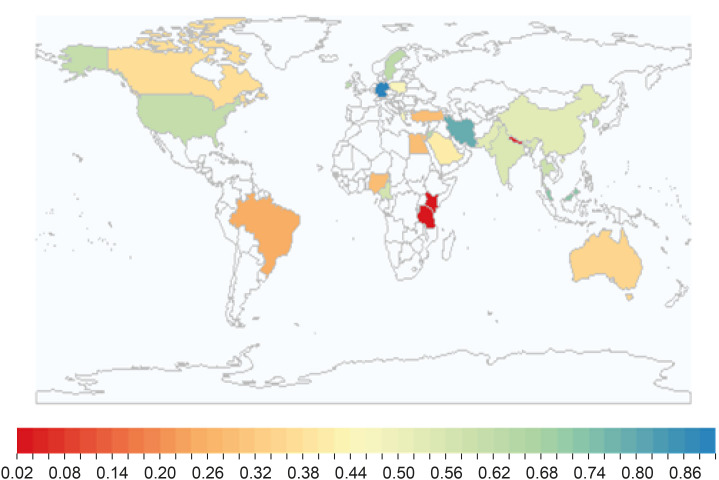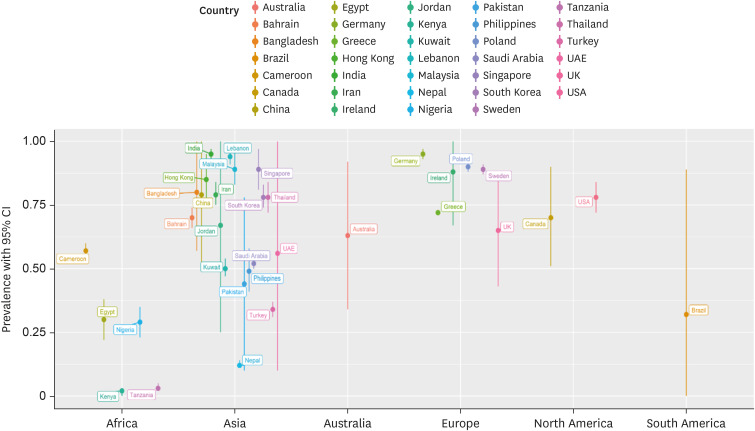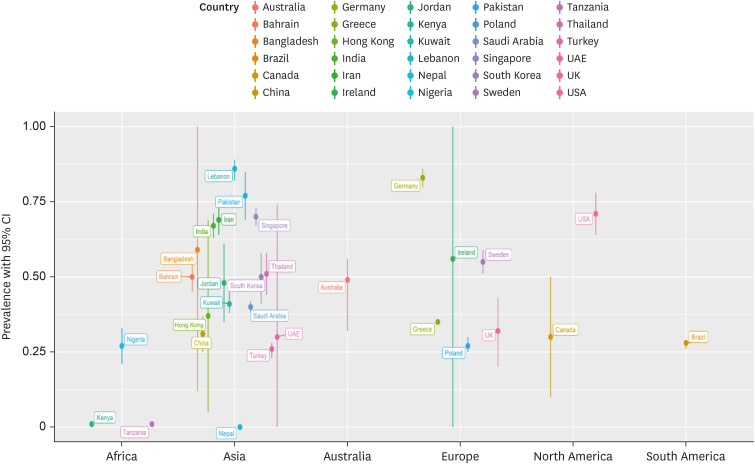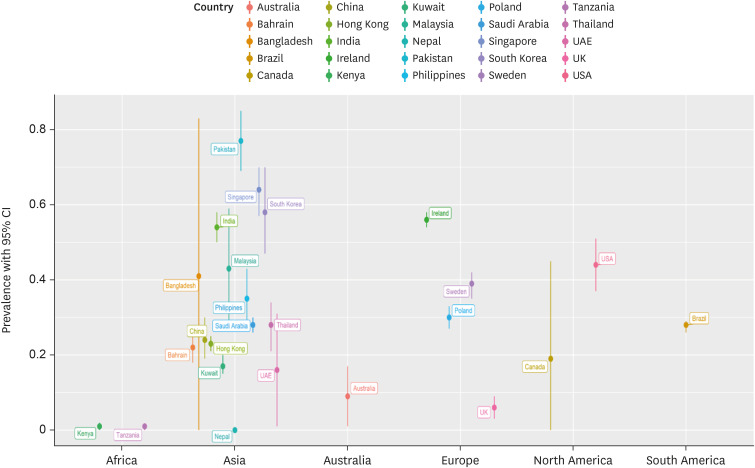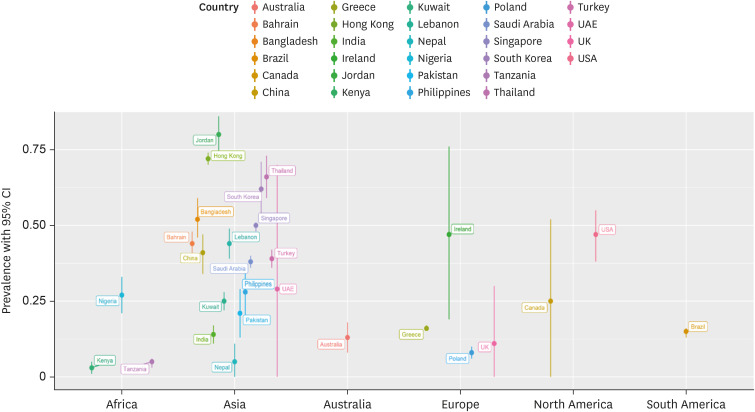Korean Circ J.
2021 Dec;51(12):983-996. 10.4070/kcj.2021.0100.
Global Awareness of Myocardial Infarction Symptoms in General Population: a Systematic Review and Meta-Analysis
- Affiliations
-
- 1Rush University Medical Center, Chicago, IL, USA
- 2Department of Community Medicine, Rajarajeswari Medical College and Hospital, Bangalore, Karnataka, India
- 3Department of Community Medicine, Mysore Medical College & Research Institute, Mysuru, Karnataka, India
- 4Directorate of Health Services, Thiruvananthapuram, Kerala, India
- 5Department of Community Medicine, Government Medical College and Hospital, Nagpur, Maharashtra, India
- 6Department of Community Medicine, SMS Medical College, Jaipur, Rajasthan, India
- 7Department of Community Medicine, Saveetha Medical College & Hospital, Chennai, Tamil Nadu, India
- 8Department of Community Medicine, Government Medical College, Srinagar, Jammu and Kashmir, India
- KMID: 2523163
- DOI: http://doi.org/10.4070/kcj.2021.0100
Abstract
- Background and Objectives
Knowledge about myocardial Infarction (MI) symptoms is crucial because inadequate awareness ensures direct association with patient delay and adverse health events subsequently.
Methods
PRISMA guidelines were followed while conducting the systematic review with PROSPERO number CRD42020219802. An electronic search was conducted comprehensively through 5 databases to find those relevant articles systematically. Prevalence was calculated for each typical symptom of MI separately and subgroup analysis according to continent, country, gender and ethnicity was done. Meta-Analysis was conducted by using statistical software R version 3.4.3. A random-effects model was used.
Results
Studies from 35 different countries with 120,988,548 individuals were included in the final analysis. The prevalence of chest pain awareness was highest, while it was lowest for jaw, back, and neck pain. There was no difference in terms of awareness in males and females. Prevalence of awareness of typical MI symptoms was higher in the Caucasian white, white, and non-Hispanic white groups than in other groups. The prevalence varies from less than 5% in African countries such as Kenya, Tanzania and Asian countries such as Nepal to as high as 90% in Germany.
Conclusions
People are well aware of chest pain as a symptom of MI. However, there is limited knowledge regarding other typical symptoms of MI.
Keyword
Figure
Cited by 2 articles
-
Global Awareness of Myocardial Infarction Symptoms in General Population
Soo-Joong Kim
Korean Circ J. 2021;51(12):997-1000. doi: 10.4070/kcj.2021.0320.Identifying and Solving Gaps in Pre- and In-Hospital Acute Myocardial Infarction Care in Asia-Pacific Countries
Paul Jie Wen Tern, Amar Vaswani, Khung Keong Yeo
Korean Circ J. 2023;53(9):594-605. doi: 10.4070/kcj.2023.0169.
Reference
-
1. GBD 2019 Diseases and Injuries Collaborators. Global burden of 369 diseases and injuries in 204 countries and territories, 1990-2019: a systematic analysis for the Global Burden of Disease Study 2019. Lancet. 2020; 396:1204–1222. PMID: 33069326.2. World Health Organization. The top 10 causes of death [Internet]. Geneva: World Health Organization;cited 2021 February 16. Available from: https://www.who.int/news-room/fact-sheets/detail/the-top-10-causes-of-death.3. World Health Organization. Health topics: cardiovascular disease [Internet]. Geneva: World Health Organization;cited 2021 February 16. Available from: https://www.who.int/health-topics/cardiovascular-diseases.4. Mathers CD, Loncar D. Projections of global mortality and burden of disease from 2002 to 2030. PLoS Med. 2006; 3:e442. PMID: 17132052.
Article5. Johns Hopkins Medicine. Heart attack [Internet]. Baltimore (MD): Johns Hopkins University;cited 2021 February 16. Available from: https://www.hopkinsmedicine.org/health/conditions-and-diseases/heart-attack.6. Simonis G, Strasser RH, Ebner B. Reperfusion injury in acute myocardial infarction. Crit Care. 2012; 16(Suppl 2):A22.
Article7. DeVon HA, Hogan N, Ochs AL, Shapiro M. Time to treatment for acute coronary syndromes: the cost of indecision. J Cardiovasc Nurs. 2010; 25:106–114. PMID: 20142752.8. Nielsen CG, Laut KG, Jensen LO, Ravkilde J, Terkelsen CJ, Kristensen SD. Patient delay in patients with ST-elevation myocardial infarction: Time patterns and predictors for a prolonged delay. Eur Heart J Acute Cardiovasc Care. 2017; 6:583–591. PMID: 27821790.
Article9. Patel A, Fang J, Gillespie C, Odom E, Luncheon C, Ayala C. Awareness of heart attack signs and symptoms and calling 9-1-1 among U.S. adults. J Am Coll Cardiol. 2018; 71:808–809. PMID: 29447744.10. Zhang QT, Hu DY, Yang JG, Zhang SY, Zhang XQ, Liu SS. Public knowledge of heart attack symptoms in Beijing residents. Chin Med J (Engl). 2007; 120:1587–1591. PMID: 17908477.
Article11. Khafaji HA, Suwaidi JM. Atypical presentation of acute and chronic coronary artery disease in diabetics. World J Cardiol. 2014; 6:802–813. PMID: 25228959.
Article12. Muhihi AJ, Anaeli A, Mpembeni RN, et al. Public knowledge of risk factors and warning signs for cardiovascular disease among young and middle-aged adults in rural Tanzania. BMC Public Health. 2020; 20:1832. PMID: 33256688.
Article13. Rahman M, Akter S, Zohora FT, Shibly AZ. Public knowledge of cardiovascular disease and its risk factors in Tangail, Bangladesh: a cross-sectional survey. Int J Community Med Public Health. 2019; 6:1838–1842.
Article14. Whitaker S, Baldwin T, Tahir M, Choudhry O, Senior A, Greenfield S. Public knowledge of the symptoms of myocardial infarction: a street survey in Birmingham, England. Fam Pract. 2012; 29:168–173. PMID: 21976661.
Article15. Lutfiyya MN, Bardales R, Bales R, et al. Awareness of heart attack and stroke symptoms among Hispanic male adults living in the United States. J Immigr Minor Health. 2010; 12:761–768. PMID: 19365727.
Article16. Park KS. Factors affecting awareness of myocardial infarction symptoms among the general public in Korea. Epidemiol Health. 2020; 42:e2020032. PMID: 32512667.17. O'Brien F, O'Donnell S, McKee G, Mooney M, Moser D. Knowledge, attitudes, and beliefs about acute coronary syndrome in patients diagnosed with ACS: an Irish cross-sectional study. Eur J Cardiovasc Nurs. 2013; 12:201–208. PMID: 22653089.18. World Health Organization. Global status report on noncommunicable diseases 2014 [Internet]. Geneva: World Health Organization;cited 2021 February 16. Available from: https://apps.who.int/iris/handle/10665/148114.19. Kronick SL, Kurz MC, Lin S, et al. Part 4: Systems of care and continuous quality improvement: 2015 American Heart Association guidelines update for cardiopulmonary resuscitation and emergency cardiovascular care. Circulation. 2015; 132:S397–S413. PMID: 26472992.
Article20. Gaziano TA, Pagidipati N. Scaling up chronic disease prevention interventions in lower- and middle-income countries. Annu Rev Public Health. 2013; 34:317–335. PMID: 23297660.
Article21. Awad A, Al-Nafisi H. Public knowledge of cardiovascular disease and its risk factors in Kuwait: a cross-sectional survey. BMC Public Health. 2014; 14:1131. PMID: 25367768.
Article22. Boateng D, Wekesah F, Browne JL, et al. Knowledge and awareness of and perception towards cardiovascular disease risk in sub-Saharan Africa: a systematic review. PLoS One. 2017; 12:e0189264. PMID: 29232703.
Article23. Jafary FH, Aslam F, Mahmud H, et al. Cardiovascular health knowledge and behavior in patient attendants at four tertiary care hospitals in Pakistan--a cause for concern. BMC Public Health. 2005; 5:124. PMID: 16309553.
Article24. McKinley S, Dracup K, Moser DK, et al. The effect of a short one-on-one nursing intervention on knowledge, attitudes and beliefs related to response to acute coronary syndrome in people with coronary heart disease: a randomized controlled trial. Int J Nurs Stud. 2009; 46:1037–1046. PMID: 19243778.
Article25. Page MJ, McKenzie JE, Bossuyt PM, et al. The PRISMA 2020 statement: an updated guideline for reporting systematic reviews. BMJ. 2021; 372:n71. PMID: 33782057.26. National Institutes of Health. Quality assessment tool for observational cohort and cross-sectional studies. Bethesda (MD): National Institutes of Health;2014. cited 2021 July 14. Available from: https://www.nhlbi.nih.gov/health-pro/guidelines/in-develop/cardiovascular-risk-reduction/tools/cohort.27. R Foundation for Statistical Computing. R: A language and environment for statistical computing. Vienna: R Foundation for Statistical Computing;2017.28. Balduzzi S, Rücker G, Schwarzer G. How to perform a meta-analysis with R: a practical tutorial. Evid Based Ment Health. 2019; 22:153–160. PMID: 31563865.
Article29. Viechtbauer W. Conducting meta-analyses in R with the metafor package. J Stat Softw. 2010; 36:1–48.
- Full Text Links
- Actions
-
Cited
- CITED
-
- Close
- Share
- Similar articles
-
- Global Awareness of Myocardial Infarction Symptoms in General Population
- Factors affecting awareness of myocardial infarction symptoms among the general public in Korea
- The Prevalence of Post-Traumatic Stress Disorder in the General Population during the COVID-19 Pandemic: A Systematic Review and Single-Arm Meta-Analysis
- Awareness of Early Symptoms and Emergency Responses to Myocardial Infarction and Stroke in People with Diabetes Mellitus Compared to Non-diabetic Population in the Community: A Propensity Score-Matched Analysis
- An Introduction of the Systematic Review and Meta-Analysis


